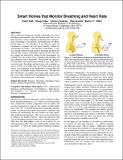| dc.contributor.author | Adib, Fadel | |
| dc.contributor.author | Mao, Hongzi | |
| dc.contributor.author | Kabelac, Zachary E. | |
| dc.contributor.author | Katabi, Dina | |
| dc.contributor.author | Miller, Robert C. | |
| dc.date.accessioned | 2018-06-12T18:19:25Z | |
| dc.date.available | 2018-06-12T18:19:25Z | |
| dc.date.issued | 2015-04 | |
| dc.identifier.isbn | 978-1-4503-3145-6 | |
| dc.identifier.uri | http://hdl.handle.net/1721.1/116277 | |
| dc.description.abstract | The evolution of ubiquitous sensing technologies has led to intelligent environments that can monitor and react to our daily activities, such as adapting our heating and cooling systems, responding to our gestures, and monitoring our elderly. In this paper, we ask whether it is possible for smart environments to monitor our vital signs remotely, without instrumenting our bodies. We introduce Vital-Radio, a wireless sensing technology that monitors breathing and heart rate without body contact. Vital-Radio exploits the fact that wireless signals are affected by motion in the environment, including chest movements due to inhaling and exhaling and skin vibrations due to heartbeats. We describe the operation of Vital-Radio and demonstrate through a user study that it can track users' breathing and heart rates with a median accuracy of 99%, even when users are 8~meters away from the device, or in a different room. Furthermore, it can monitor the vital signs of multiple people simultaneously. We envision that Vital-Radio can enable smart homes that monitor people's vital signs without body instrumentation, and actively contribute to their inhabitants' well-being. | en_US |
| dc.description.sponsorship | National Science Foundation (U.S.) | en_US |
| dc.description.sponsorship | Microsoft Research (PhD Fellowship) | en_US |
| dc.language.iso | en_US | |
| dc.publisher | Association for Computing Machinery | en_US |
| dc.relation.isversionof | http://dx.doi.org/10.1145/2702123.2702200 | en_US |
| dc.rights | Creative Commons Attribution-Noncommercial-Share Alike | en_US |
| dc.rights.uri | http://creativecommons.org/licenses/by-nc-sa/4.0/ | en_US |
| dc.source | MIT Web Domain | en_US |
| dc.title | Smart Homes that Monitor Breathing and Heart Rate | en_US |
| dc.type | Article | en_US |
| dc.identifier.citation | Adib, Fadel, et al. "Smart Homes That Monitor Breathing and Heart Rate." CHI '15 Proceedings of the 33rd Annual ACM Conference on Human Factors in Computing Systems, 18-23 April, 2015, Seoul, Republic of Korea, ACM Press, 2015, pp. 837–46. | en_US |
| dc.contributor.department | Massachusetts Institute of Technology. Department of Electrical Engineering and Computer Science | en_US |
| dc.contributor.department | Program in Media Arts and Sciences (Massachusetts Institute of Technology) | en_US |
| dc.contributor.mitauthor | Adib, Fadel | |
| dc.contributor.mitauthor | Mao, Hongzi | |
| dc.contributor.mitauthor | Kabelac, Zachary E. | |
| dc.contributor.mitauthor | Katabi, Dina | |
| dc.contributor.mitauthor | Miller, Robert C | |
| dc.relation.journal | Proceedings of the 33rd Annual ACM Conference on Human Factors in Computing Systems - CHI '15 | en_US |
| dc.eprint.version | Author's final manuscript | en_US |
| dc.type.uri | http://purl.org/eprint/type/ConferencePaper | en_US |
| eprint.status | http://purl.org/eprint/status/NonPeerReviewed | en_US |
| dspace.orderedauthors | Adib, Fadel; Mao, Hongzi; Kabelac, Zachary; Katabi, Dina; Miller, Robert C. | en_US |
| dspace.embargo.terms | N | en_US |
| dc.identifier.orcid | https://orcid.org/0000-0003-2593-2069 | |
| dc.identifier.orcid | https://orcid.org/0000-0003-1813-4456 | |
| dc.identifier.orcid | https://orcid.org/0000-0001-8835-7810 | |
| dc.identifier.orcid | https://orcid.org/0000-0003-4854-4157 | |
| dc.identifier.orcid | https://orcid.org/0000-0002-0442-691X | |
| mit.license | OPEN_ACCESS_POLICY | en_US |
